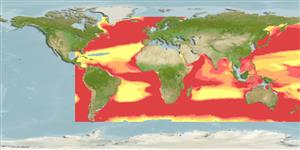Teleostei (teleosts) >
Alepocephaliformes (Slickheads and tubeshoulders.) >
Alepocephalidae (Slickheads)
Etymology: Xenodermichthys: Greek, xenos = strange + Greek, derma = skin + Greek, ichthys = fish (Ref. 45335).
More on author: Gill.
Environment: milieu / climate zone / depth range / distribution range
Ecology
Marine; bathypelagic; depth range 100 - 2650 m (Ref. 4460), usually 100 - 1230 m (Ref. 47377). Deep-water; 70°N - 56°S, 90°W - 180°E (Ref. 57340)
Atlantic Ocean: widely distributed, ranging north to Iceland in the eastern section (Ref. 4460). Pacific Ocean: on both sides, in tropical waters; Tasman Sea. Indian Ocean: including Great Australian Bight.
Size / Weight / Age
Maturity: Lm ? range ? - ? cm
Max length : 31.0 cm TL male/unsexed; (Ref. 57911)
Usually found near continental slopes (Ref. 4736). Bathypelagic (Ref. 58426). Feeds primarily on crustaceans (euphausiids, copepods, amphipods and decapod zoea), also ostracods and small cephalopods (Ref. 4736).
Life cycle and mating behavior
Maturities | Reproduction | Spawnings | Egg(s) | Fecundities | Larvae
Markle, D.F., 1986. Alepocephalidae. p. 218-223. In M.M. Smith and P.C. Heemstra (eds.) Smiths' sea fishes. Springer-Verlag, Berlin. (Ref. 2711)
IUCN Red List Status (Ref. 130435)
Threat to humans
Harmless
Human uses
Fisheries: of no interest
Tools
Special reports
Download XML
Internet sources
Estimates based on models
Preferred temperature (Ref.
123201): 3 - 19.7, mean 7.6 °C (based on 4609 cells).
Phylogenetic diversity index (Ref.
82804): PD
50 = 0.7500 [Uniqueness, from 0.5 = low to 2.0 = high].
Bayesian length-weight: a=0.00347 (0.00164 - 0.00733), b=3.19 (3.00 - 3.38), in cm total length, based on LWR estimates for this (Sub)family-body shape (Ref.
93245).
Trophic level (Ref.
69278): 3.2 ±0.35 se; based on food items.
Resilience (Ref.
120179): Medium, minimum population doubling time 1.4 - 4.4 years (Assuming tmax>3).
Fishing Vulnerability (Ref.
59153): Low vulnerability (21 of 100).
Nutrients (Ref.
124155): Calcium = 18.9 [5.2, 84.2] mg/100g; Iron = 0.422 [0.123, 1.324] mg/100g; Protein = 14 [11, 17] %; Omega3 = 0.165 [0.052, 0.541] g/100g; Selenium = 12.8 [3.5, 51.4] μg/100g; VitaminA = 37.4 [5.1, 305.3] μg/100g; Zinc = 0.561 [0.250, 1.389] mg/100g (wet weight);
